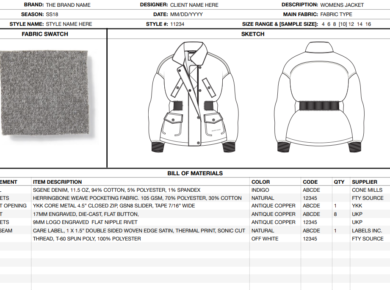Nearshoring is an increasingly popular sourcing strategy for fashion brands looking to optimize their supply chain and reduce costs. It involves sourcing products from nearby countries or regions rather than outsourcing from more distant locations, such as Asia. In this article, we will discuss the strategic benefits of nearshoring for fashion brands as well as highlight the potential negatives and provide solutions on overcoming those hurdles.
Benefits of Nearshoring
1. Lower cost
Nearshoring can help fashion brands considerably reduce costs. Offshoring forces brands to absorb huge transportation costs due to the long distances products must travel. By sourcing products from nearby countries brands can significantly reduce those shipping and transportation costs. Sourcing from nearby countries can also help brands maintain lower labour costs as wages are often lower in nearby countries compared to Western countries.
2. Faster lead times
Minimising lead time is critical for meeting customer demands and keeping up with fast-changing fashion trends. By sourcing products from nearby countries, brands can reduce shipping times, thereby speeding up the entire supply chain process.
Nearshoring has seen a rise since Covid-19, which highlighted the risks of sourcing from longer lead time markets like China. Many brands found themselves in the difficult position unable to get stock from suppliers compounded with their long lead times, leaving many of their products out of stock. This led to a decrease in sales for many brands as customers were left without access to products.
Sourcing from countries closer to customers and fashion brands’ operations can reduce disruptions and improve the availability of stock.
3. Better quality control
Sourcing products from nearby countries increases factory accessibility for brands. This gives brands the opportunity to easily visit factories, conduct inspections, and ensure that quality standards are met. This helps reduce the risk of product defects and returns, which can be costly for brands.
To find out more on how to reduce risk in sourcing – READ OUR BLOG HERE
4. Ethical and sustainable practices
Nearshoring can help brands notably reduce their carbon footprint by dramatically decreasing shipping and transport times and distance. Additionally, by sourcing from nearby countries, brands can ensure that workers are treated fairly and that ethical labour practices are upheld as they are able to visit the factories on a more regular basis.

Potential Negatives of Nearshoring
1. Limited Availability of Suppliers
One potential negative of nearshoring is the potential limited availability of suppliers in nearby countries. This can make it challenging for brands to find the right supplier with the necessary production capacity and expertise.
2. Higher Labour Costs Compared to Outsourcing to Asia
Although wages may be lower in nearby countries compared to Western countries, they may still be higher than in some Asian countries. This may result in higher labour costs compared to outsourcing to Asia.
3. Limited Product Expertise
The long history of outsourcing to Asia has created a robust and knowledgeable supplier industry in the continent. Comparatively, there may be limited product expertise in nearby countries. Brands may find it challenging to discover the right supplier with the necessary expertise and skills to produce complex products.
How to Overcome the Potential Negatives of Nearshoring
Expand the Supplier Network
To overcome the limited availability of suppliers in nearby countries, brands can expand their supplier network by exploring different regions within the same country or neighbouring countries. Having good access to the market and knowing the top manufacturers and suppliers in the region and country will enable fashion brands to find the right supplier for their business.
Negotiate with Suppliers
Negotiating with suppliers is one way to mitigate the higher labour costs of nearshoring compared to outsourcing in Asia. Brands should also explore different pricing models, such as volume-based discounts and long-term partnerships to further decrease sourcing costs.
To find out more on how to successfully negotiate with your suppliers – READ OUR BLOG HERE
Invest in Product Expertise
To increase their suppliers’ expertise, brands can invest in training and development programs for their suppliers, as well as provide technical assistance and support. Investing in suppliers can also strengthen the relationship of the brand with the supplier and lead the supplier to prioritise the brand in production.
In conclusion, nearshoring can be a strategic action plan for fashion brands looking to optimise their supply chain and reduce costs. By sourcing products from nearby countries, brands can benefit from lower costs, faster lead times, better quality control, and more ethical and sustainable practices. However, brands should also consider potential issues of nearshoring, such as limited availability of suppliers, higher labour costs compared to outsourcing to Asia, and limited product expertise. By expanding supplier networks, negotiating with suppliers, and investing in product expertise, brands can overcome these challenges and make the most of their nearshoring strategy.
Popular Nearshoring Destinations for Fashion Brands
Brands based in the EU market
Brands operating in the EU market typically choose to nearshore from within the EU market or from countries mid-way between Europe and Asia. Some of the most popular countries include:
- Turkey
- Italy
- Portugal
- Spain
- Egypt
- Morocco
Brands based in the US market
For brands operating in the US market, nearshoring typically includes countries from central and South America. The most common are:
- Mexico
- Guatemala
- Honduras
- El Salvador
- Peru
- Brazil
- Dominican Republic
To find suppliers and manufacturers in nearshore markets, check out Sourcing Playground’s AI sourcing database with a 7 day free trial.






